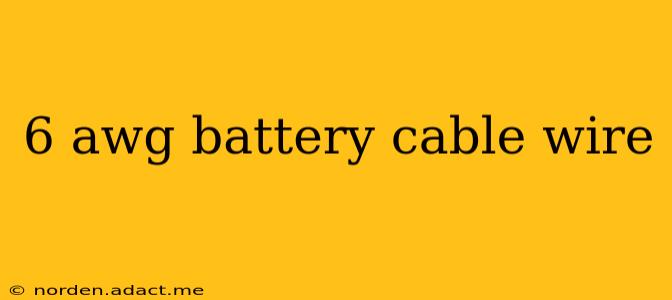6 AWG (American Wire Gauge) battery cable is a common choice for high-current applications, particularly in automotive, marine, and industrial settings. Its thicker gauge signifies a greater capacity to handle significant amperage without overheating or experiencing significant voltage drop. This guide will delve into the specifics of 6 AWG battery cable, addressing common questions and providing valuable insights for those working with high-power systems.
What is 6 AWG Battery Cable Used For?
6 AWG battery cable's robust construction makes it ideal for situations demanding substantial current flow. Its primary applications include:
- Automotive Applications: Powering high-drain accessories like amplifiers, winches, and high-intensity lighting systems. It's often used for connecting the battery to the alternator and starter.
- Marine Applications: Providing power to trolling motors, bilge pumps, and other high-current marine devices. Its resistance to corrosion is crucial in saltwater environments.
- Industrial Applications: Used in various industrial settings where heavy-duty power transmission is necessary. This can range from powering machinery to connecting batteries in uninterruptible power supply (UPS) systems.
- Solar Power Systems: While smaller gauge wires might be used for individual panels, 6 AWG can be used for the main runs connecting panels to charge controllers and battery banks in larger systems.
What Size Fuse Should I Use with 6 AWG Battery Cable?
The appropriate fuse size for 6 AWG battery cable depends on several factors, primarily the amperage draw of the connected load. It's crucial to select a fuse with a rating slightly higher than the maximum expected current draw, providing protection without unnecessary tripping. Never underestimate the current draw; consult the specifications of your equipment. Using a fuse calculator or seeking advice from an electrician is recommended to determine the correct fuse rating. Incorrect fusing can lead to equipment damage or fire hazards.
What is the Ampacity of 6 AWG Battery Cable?
The ampacity (current-carrying capacity) of 6 AWG battery cable isn't a fixed value. It varies depending on several factors:
- Insulation Type: Different insulation materials (e.g., PVC, silicone) have varying heat resistance, impacting the ampacity.
- Ambient Temperature: Higher temperatures reduce the cable's ability to dissipate heat, thus lowering its ampacity.
- Installation Method: Cable bundled tightly will dissipate heat less effectively than cables with good air circulation.
- Cable Length: Longer runs of cable will experience more voltage drop and potential heating.
Consult the cable manufacturer's specifications for the precise ampacity under specific conditions. Always use the ampacity rating provided under the most conservative circumstances to ensure safe operation.
How Long Can I Run 6 AWG Battery Cable Before Experiencing Significant Voltage Drop?
Voltage drop is inevitable over longer cable runs, especially at high currents. The longer the cable, the greater the resistance, leading to a reduction in voltage reaching the load. Excessive voltage drop can impair the performance of connected equipment, causing malfunctions or damage. The acceptable voltage drop is application-specific, but typically should be kept below 5%. Using a voltage drop calculator with the cable's specific resistance and the expected current will help determine the maximum acceptable length for your application.
Is 6 AWG Battery Cable Suitable for My Application?
Determining whether 6 AWG battery cable is appropriate for your specific needs requires careful consideration of the load's current requirements and the installation conditions. If you're unsure, consulting a qualified electrician is always advisable. Overestimating the cable's capacity is safer than underestimating it, as this could lead to overheating and potentially dangerous situations.
Conclusion
6 AWG battery cable provides a robust and reliable solution for high-current applications. However, understanding its limitations and selecting appropriate fuses and cable lengths are paramount to ensure safe and efficient operation. Always prioritize safety by consulting relevant specifications and, if needed, seeking expert advice.
